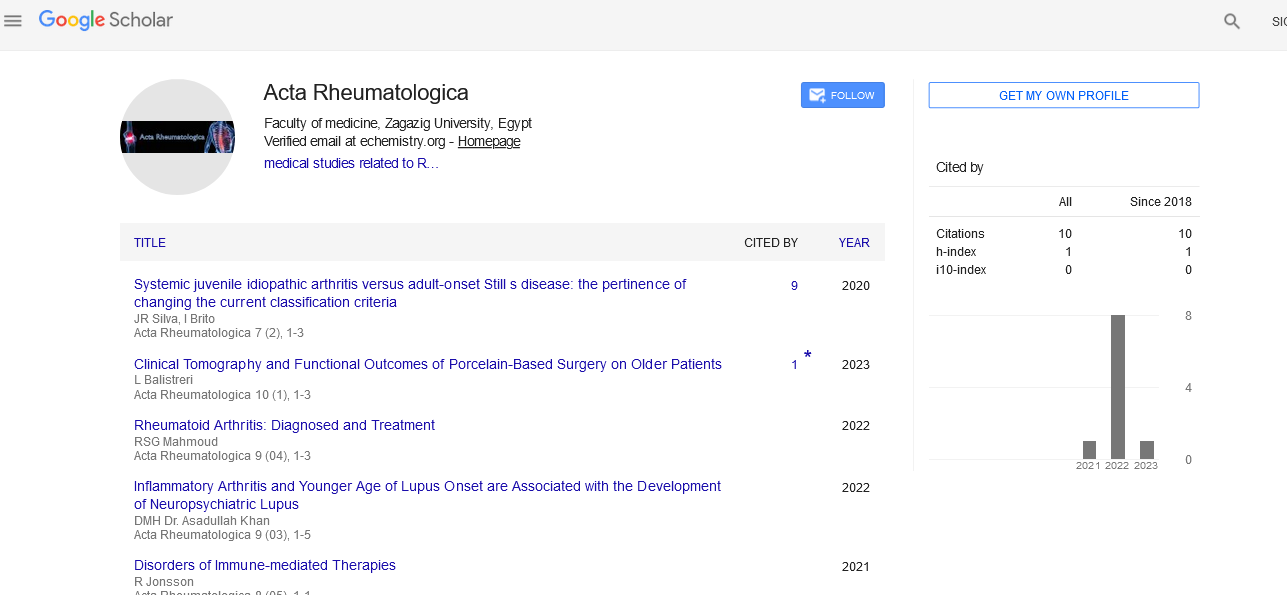Williams Matthew*
Department of Pathology, University of Utah, Utah, USA
- *Corresponding Author:
- Williams Matthew
Department of Pathology,
University of Utah, Utah, USA.
E-mail: Williams.matthew@hotmail.com
Received Date: October 08, 2021; Accepted Date: October 22, 2021; Published Date: October 29,2021
Citation: Matthew W (2021) Non- Radiographic Axial Spondyloarthritis. Acta Rheuma. Vol.8 No.5:1.
Commentary
Chronic diseases are usually associated with poor physical function, decreased health-related quality of life (HR-QoL), and work incapacity, imposing a significant cost on patients, family and friends, the healthcare system, and society as a whole. Spondyloarthritis (SpA) refers to a group of chronic rheumatic illnesses that share a genetic link with the major histocompatibility complex class 1 antigen (HLA-B27) and shared clinical symptoms. Chronic back pain with start before the age of 45 years, as well as articular features such as enthesitis, arthritis, dactylitis, and extraarticular abnormalities such as psoriasis, inflammatory bowel disease (IBD), or uveitis, are used to classify patients in the various SpA-related disorders. Patients are often diagnosed as having ankylosing spondylitis, psoriatic arthritis (PsA), enteropathic arthritis/spondylitis, or reactive arthritis based on their clinical presentation. A more recent unifying idea proposed dividing SpA into axial and peripheral SpA.
The term spondyloarthritis (SpA) refers to a category of rheumatic disorders that includes the prototypical ankylosing spondylitis (AS) and variations of psoriatic arthritis. SpA patients are genetically connected. They may present with inflammatory back pain (IBP), peripheral symptoms such as enthesitis or arthritis, and extraarticular signs such as anterior uveitis, psoriasis, and chronic inflammatory bowel disease. The majority of individuals with axial SpA (axSpA) have objective symptoms of inflammation on imaging, such as sacroiliitis and spondylitis4, or in laboratory tests, such as C reactive protein (CRP) or erythrocyte sedimentation rate. Furthermore, many individuals, particularly those who have human leucocyte antigen (HLA) B27 positivity, have a positive family history of SpA or similar disorders.
Moll and Wright recognised the idea of spondyloarthritis decades ago, and classification of patients as having AS has based on the modified New York criteria, in which conventional radiography of the sacroiliac joints revealing more or less evident structural abnormalities were most significant. Following that, two further sets of criteria were published in order to categorise individuals presenting with axial and peripheral symptoms, even in the absence of radiological injury in the sacroiliac joints.
The MRI period, which began 20 years ago, has helped to a better assessment of patients with early axSpA disease stages. The publishing of revised axSpA categorization criteria, which include, in addition to conventional radiographs indicating structural alterations, positive findings acquired by MRI of the sacroiliac joints demonstrating inflammation, and HLA-B27 as an entry criterion, has enlarged the SpA spectrum. This breakthrough has sparked clinical research comparing the two axSpA subtypes, nonradiographic (nr-axSpA) and radiographic (AS) axSpA. However, in daily practise, this differentiation has not been regarded beneficial in terms of patient diagnosis.
The goal of this overview is to describe and discuss the similarities and differences between the two axSpA subgroups, primarily using data from three studies that looked at cohorts from various origins: one local study, one national study (German SpA Inception Cohort (GESPIC)), where additional information on patients with radiographic axSpA with shorter (5 years) and longer (>5 years) disease duration was also provided, and one international study.
41355





